Quantitative Analysis of Customer Satisfaction for FPM Report
VerifiedAdded on 2023/01/12
|13
|1890
|32
Report
AI Summary
This report provides a quantitative analysis of Frogmore Paper Manufacturers (FPM), focusing on customer satisfaction, likelihood to recommend and purchase based on performance variables. The study utilizes T-tests and ANOVA to analyze data collected from two customer groups: the Magazine industry and the Book Publishing Industry. Key variables such as product quality, e-commerce, and competitive pricing are examined to determine their impact on customer perceptions. The report highlights significant differences in customer views regarding e-commerce and competitive pricing, while other variables show similar trends. Recommendations include conducting periodic surveys, creating customer profiles, implementing new tools and techniques, and continuously tracking customer behavior to enhance understanding and improve marketing strategies. The analysis concludes that product quality significantly influences customer satisfaction and provides insights for FPM to refine its marketing approaches.
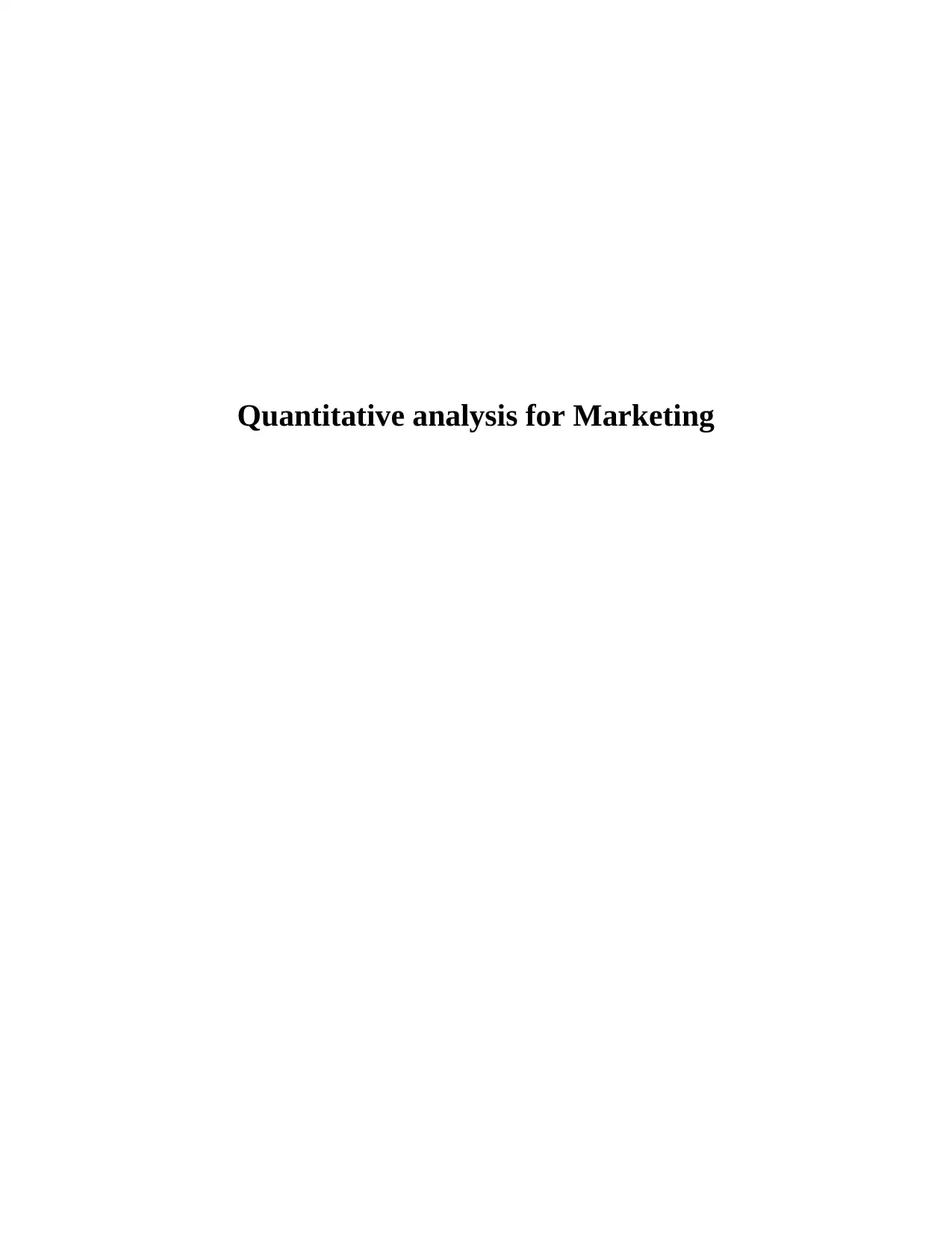
Quantitative analysis for Marketing
Paraphrase This Document
Need a fresh take? Get an instant paraphrase of this document with our AI Paraphraser
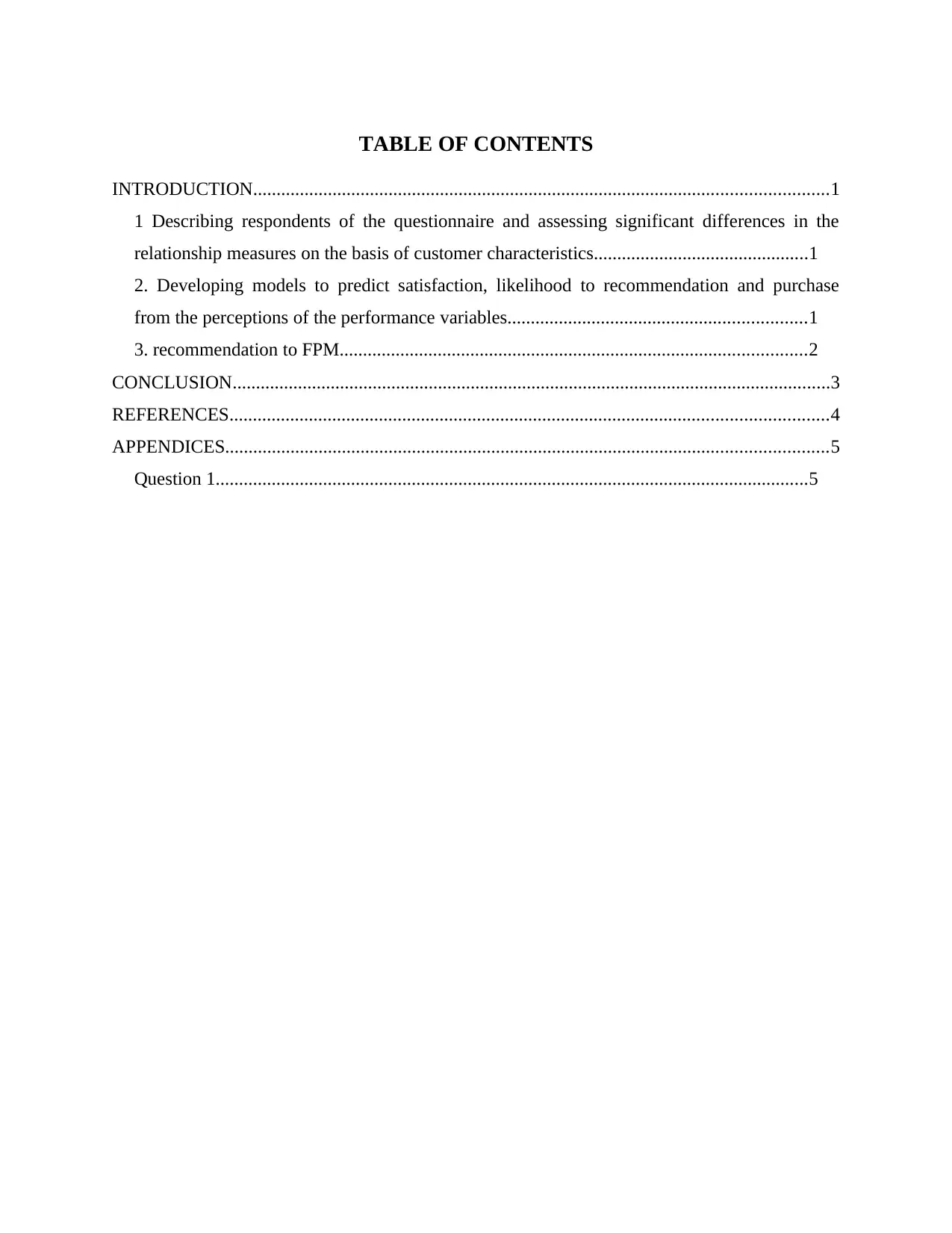
TABLE OF CONTENTS
INTRODUCTION...........................................................................................................................1
1 Describing respondents of the questionnaire and assessing significant differences in the
relationship measures on the basis of customer characteristics..............................................1
2. Developing models to predict satisfaction, likelihood to recommendation and purchase
from the perceptions of the performance variables................................................................1
3. recommendation to FPM....................................................................................................2
CONCLUSION................................................................................................................................3
REFERENCES................................................................................................................................4
APPENDICES.................................................................................................................................5
Question 1...............................................................................................................................5
INTRODUCTION...........................................................................................................................1
1 Describing respondents of the questionnaire and assessing significant differences in the
relationship measures on the basis of customer characteristics..............................................1
2. Developing models to predict satisfaction, likelihood to recommendation and purchase
from the perceptions of the performance variables................................................................1
3. recommendation to FPM....................................................................................................2
CONCLUSION................................................................................................................................3
REFERENCES................................................................................................................................4
APPENDICES.................................................................................................................................5
Question 1...............................................................................................................................5
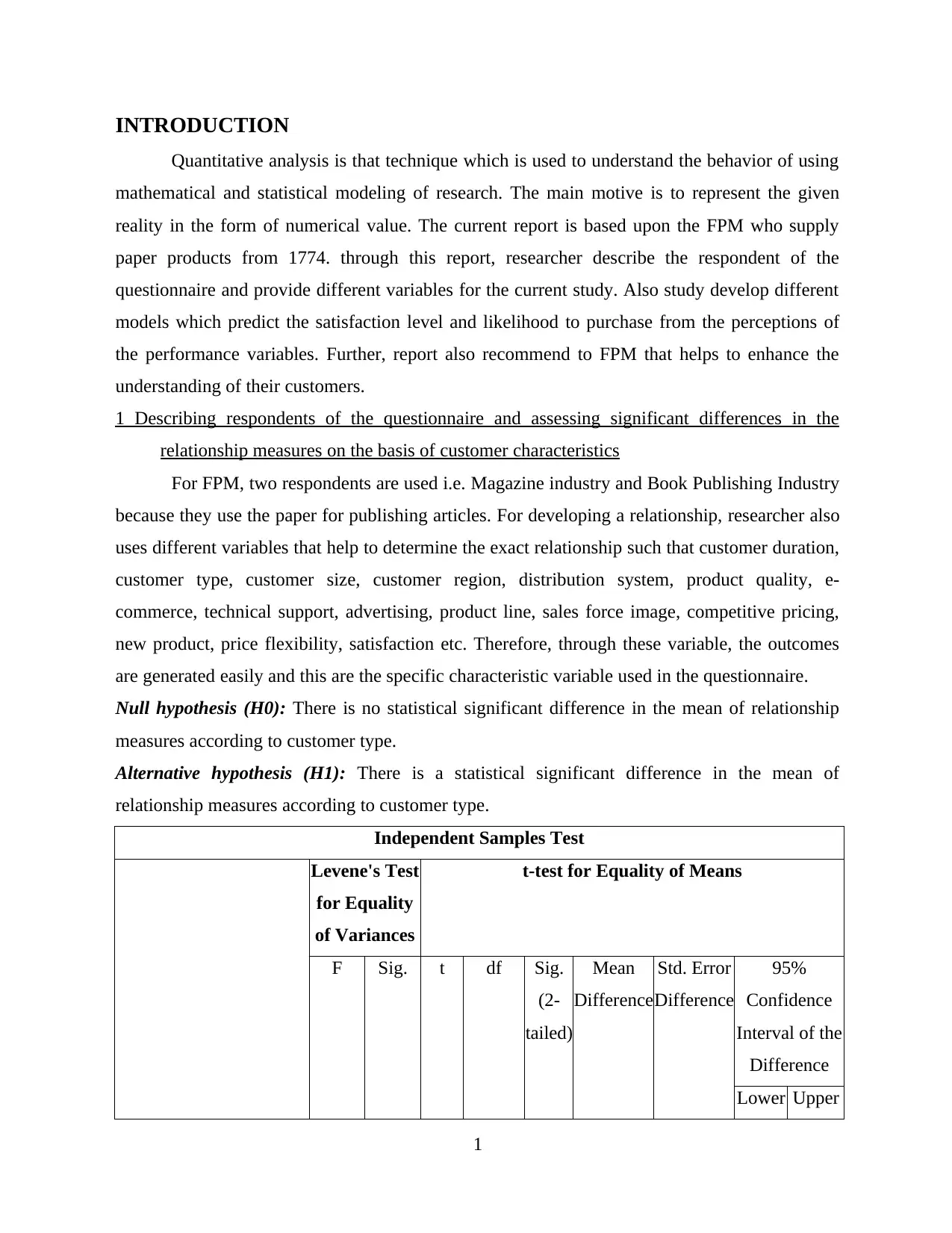
INTRODUCTION
Quantitative analysis is that technique which is used to understand the behavior of using
mathematical and statistical modeling of research. The main motive is to represent the given
reality in the form of numerical value. The current report is based upon the FPM who supply
paper products from 1774. through this report, researcher describe the respondent of the
questionnaire and provide different variables for the current study. Also study develop different
models which predict the satisfaction level and likelihood to purchase from the perceptions of
the performance variables. Further, report also recommend to FPM that helps to enhance the
understanding of their customers.
1 Describing respondents of the questionnaire and assessing significant differences in the
relationship measures on the basis of customer characteristics
For FPM, two respondents are used i.e. Magazine industry and Book Publishing Industry
because they use the paper for publishing articles. For developing a relationship, researcher also
uses different variables that help to determine the exact relationship such that customer duration,
customer type, customer size, customer region, distribution system, product quality, e-
commerce, technical support, advertising, product line, sales force image, competitive pricing,
new product, price flexibility, satisfaction etc. Therefore, through these variable, the outcomes
are generated easily and this are the specific characteristic variable used in the questionnaire.
Null hypothesis (H0): There is no statistical significant difference in the mean of relationship
measures according to customer type.
Alternative hypothesis (H1): There is a statistical significant difference in the mean of
relationship measures according to customer type.
Independent Samples Test
Levene's Test
for Equality
of Variances
t-test for Equality of Means
F Sig. t df Sig.
(2-
tailed)
Mean
Difference
Std. Error
Difference
95%
Confidence
Interval of the
Difference
Lower Upper
1
Quantitative analysis is that technique which is used to understand the behavior of using
mathematical and statistical modeling of research. The main motive is to represent the given
reality in the form of numerical value. The current report is based upon the FPM who supply
paper products from 1774. through this report, researcher describe the respondent of the
questionnaire and provide different variables for the current study. Also study develop different
models which predict the satisfaction level and likelihood to purchase from the perceptions of
the performance variables. Further, report also recommend to FPM that helps to enhance the
understanding of their customers.
1 Describing respondents of the questionnaire and assessing significant differences in the
relationship measures on the basis of customer characteristics
For FPM, two respondents are used i.e. Magazine industry and Book Publishing Industry
because they use the paper for publishing articles. For developing a relationship, researcher also
uses different variables that help to determine the exact relationship such that customer duration,
customer type, customer size, customer region, distribution system, product quality, e-
commerce, technical support, advertising, product line, sales force image, competitive pricing,
new product, price flexibility, satisfaction etc. Therefore, through these variable, the outcomes
are generated easily and this are the specific characteristic variable used in the questionnaire.
Null hypothesis (H0): There is no statistical significant difference in the mean of relationship
measures according to customer type.
Alternative hypothesis (H1): There is a statistical significant difference in the mean of
relationship measures according to customer type.
Independent Samples Test
Levene's Test
for Equality
of Variances
t-test for Equality of Means
F Sig. t df Sig.
(2-
tailed)
Mean
Difference
Std. Error
Difference
95%
Confidence
Interval of the
Difference
Lower Upper
1
⊘ This is a preview!⊘
Do you want full access?
Subscribe today to unlock all pages.

Trusted by 1+ million students worldwide
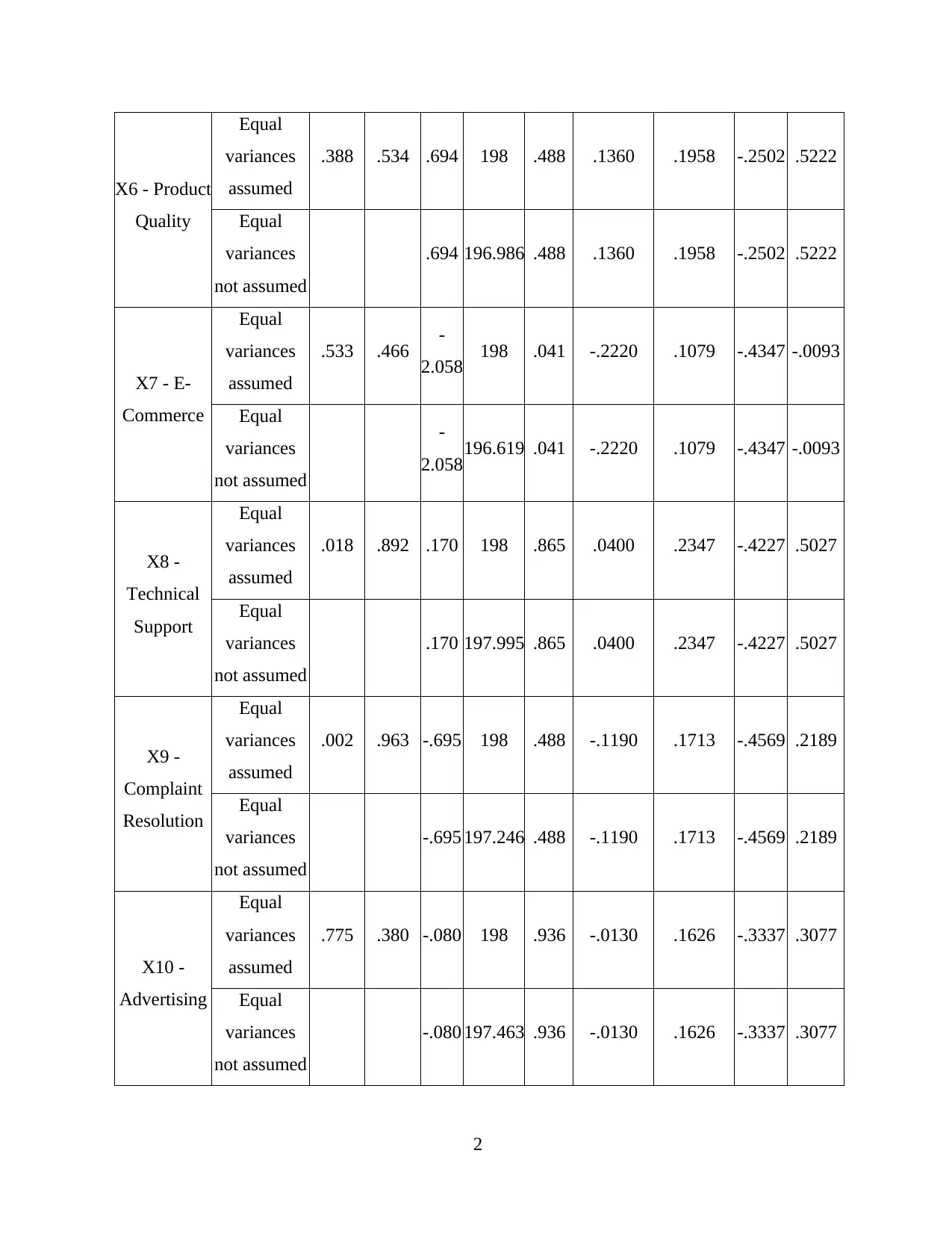
X6 - Product
Quality
Equal
variances
assumed
.388 .534 .694 198 .488 .1360 .1958 -.2502 .5222
Equal
variances
not assumed
.694 196.986 .488 .1360 .1958 -.2502 .5222
X7 - E-
Commerce
Equal
variances
assumed
.533 .466 -
2.058 198 .041 -.2220 .1079 -.4347 -.0093
Equal
variances
not assumed
-
2.058196.619 .041 -.2220 .1079 -.4347 -.0093
X8 -
Technical
Support
Equal
variances
assumed
.018 .892 .170 198 .865 .0400 .2347 -.4227 .5027
Equal
variances
not assumed
.170 197.995 .865 .0400 .2347 -.4227 .5027
X9 -
Complaint
Resolution
Equal
variances
assumed
.002 .963 -.695 198 .488 -.1190 .1713 -.4569 .2189
Equal
variances
not assumed
-.695 197.246 .488 -.1190 .1713 -.4569 .2189
X10 -
Advertising
Equal
variances
assumed
.775 .380 -.080 198 .936 -.0130 .1626 -.3337 .3077
Equal
variances
not assumed
-.080 197.463 .936 -.0130 .1626 -.3337 .3077
2
Quality
Equal
variances
assumed
.388 .534 .694 198 .488 .1360 .1958 -.2502 .5222
Equal
variances
not assumed
.694 196.986 .488 .1360 .1958 -.2502 .5222
X7 - E-
Commerce
Equal
variances
assumed
.533 .466 -
2.058 198 .041 -.2220 .1079 -.4347 -.0093
Equal
variances
not assumed
-
2.058196.619 .041 -.2220 .1079 -.4347 -.0093
X8 -
Technical
Support
Equal
variances
assumed
.018 .892 .170 198 .865 .0400 .2347 -.4227 .5027
Equal
variances
not assumed
.170 197.995 .865 .0400 .2347 -.4227 .5027
X9 -
Complaint
Resolution
Equal
variances
assumed
.002 .963 -.695 198 .488 -.1190 .1713 -.4569 .2189
Equal
variances
not assumed
-.695 197.246 .488 -.1190 .1713 -.4569 .2189
X10 -
Advertising
Equal
variances
assumed
.775 .380 -.080 198 .936 -.0130 .1626 -.3337 .3077
Equal
variances
not assumed
-.080 197.463 .936 -.0130 .1626 -.3337 .3077
2
Paraphrase This Document
Need a fresh take? Get an instant paraphrase of this document with our AI Paraphraser

X11 -
Product Line
Equal
variances
assumed
.762 .384 .396 198 .692 .0740 .1867 -.2942 .4422
Equal
variances
not assumed
.396 191.723 .692 .0740 .1867 -.2943 .4423
X12 -
Salesforce
Image
Equal
variances
assumed
.080 .777 -.075 198 .940 -.0120 .1600 -.3275 .3035
Equal
variances
not assumed
-.075 196.354 .940 -.0120 .1600 -.3275 .3035
X13 -
Competitive
Pricing
Equal
variances
assumed
5.116 .025 -
2.120 198 .035 -.4700 .2217 -.9072 -.0328
Equal
variances
not assumed
-
2.120191.785 .035 -.4700 .2217 -.9073 -.0327
X14 -
Warranty &
Claims
Equal
variances
assumed
2.403 .123 .411 198 .681 .0510 .1241 -.1936 .2956
Equal
variances
not assumed
.411 195.934 .681 .0510 .1241 -.1936 .2956
X15 - New
Products
Equal
variances
assumed
.917 .339 1.293 198 .198 .2730 .2112 -.1435 .6895
Equal
variances
not assumed
1.293196.454 .198 .2730 .2112 -.1435 .6895
3
Product Line
Equal
variances
assumed
.762 .384 .396 198 .692 .0740 .1867 -.2942 .4422
Equal
variances
not assumed
.396 191.723 .692 .0740 .1867 -.2943 .4423
X12 -
Salesforce
Image
Equal
variances
assumed
.080 .777 -.075 198 .940 -.0120 .1600 -.3275 .3035
Equal
variances
not assumed
-.075 196.354 .940 -.0120 .1600 -.3275 .3035
X13 -
Competitive
Pricing
Equal
variances
assumed
5.116 .025 -
2.120 198 .035 -.4700 .2217 -.9072 -.0328
Equal
variances
not assumed
-
2.120191.785 .035 -.4700 .2217 -.9073 -.0327
X14 -
Warranty &
Claims
Equal
variances
assumed
2.403 .123 .411 198 .681 .0510 .1241 -.1936 .2956
Equal
variances
not assumed
.411 195.934 .681 .0510 .1241 -.1936 .2956
X15 - New
Products
Equal
variances
assumed
.917 .339 1.293 198 .198 .2730 .2112 -.1435 .6895
Equal
variances
not assumed
1.293196.454 .198 .2730 .2112 -.1435 .6895
3
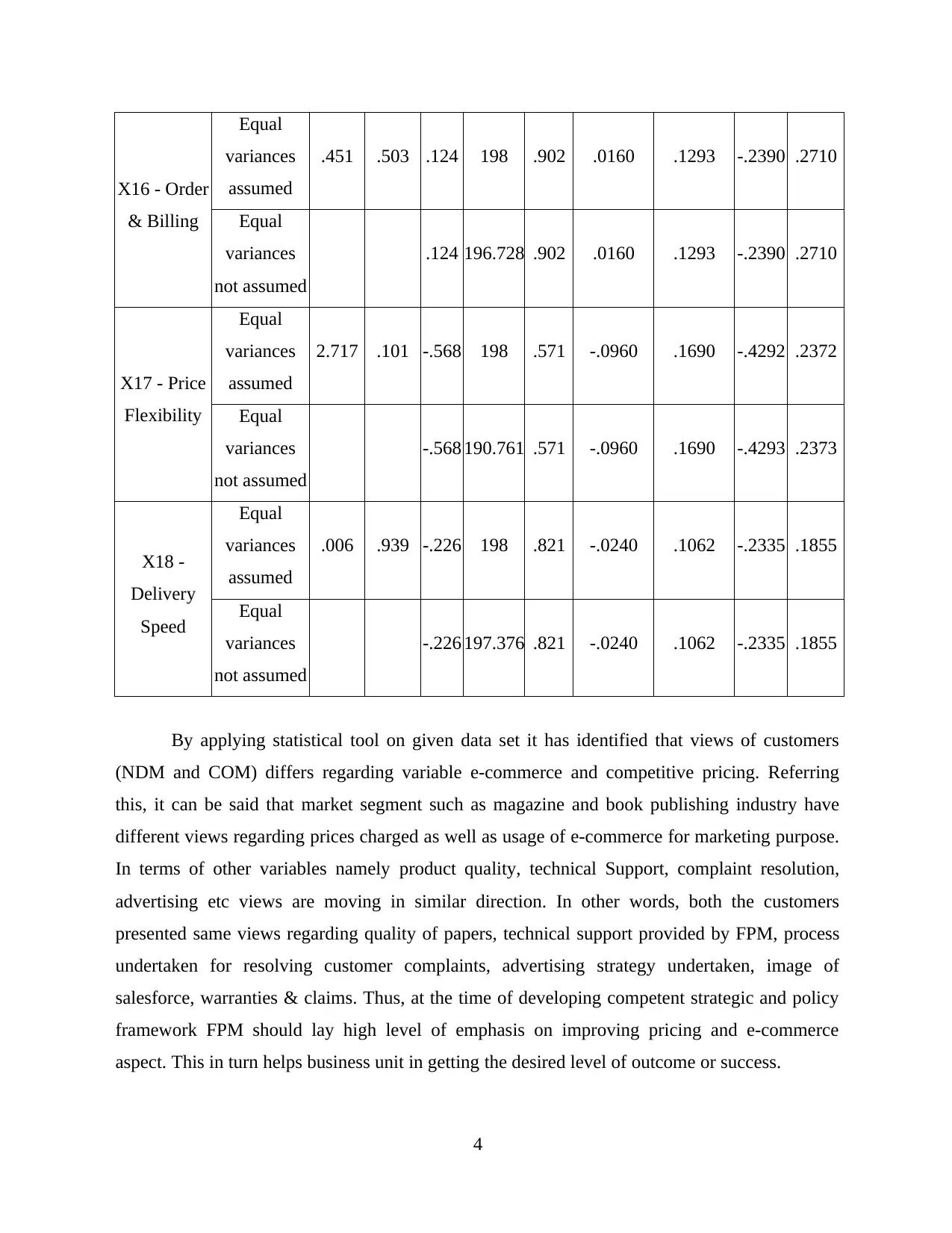
X16 - Order
& Billing
Equal
variances
assumed
.451 .503 .124 198 .902 .0160 .1293 -.2390 .2710
Equal
variances
not assumed
.124 196.728 .902 .0160 .1293 -.2390 .2710
X17 - Price
Flexibility
Equal
variances
assumed
2.717 .101 -.568 198 .571 -.0960 .1690 -.4292 .2372
Equal
variances
not assumed
-.568 190.761 .571 -.0960 .1690 -.4293 .2373
X18 -
Delivery
Speed
Equal
variances
assumed
.006 .939 -.226 198 .821 -.0240 .1062 -.2335 .1855
Equal
variances
not assumed
-.226 197.376 .821 -.0240 .1062 -.2335 .1855
By applying statistical tool on given data set it has identified that views of customers
(NDM and COM) differs regarding variable e-commerce and competitive pricing. Referring
this, it can be said that market segment such as magazine and book publishing industry have
different views regarding prices charged as well as usage of e-commerce for marketing purpose.
In terms of other variables namely product quality, technical Support, complaint resolution,
advertising etc views are moving in similar direction. In other words, both the customers
presented same views regarding quality of papers, technical support provided by FPM, process
undertaken for resolving customer complaints, advertising strategy undertaken, image of
salesforce, warranties & claims. Thus, at the time of developing competent strategic and policy
framework FPM should lay high level of emphasis on improving pricing and e-commerce
aspect. This in turn helps business unit in getting the desired level of outcome or success.
4
& Billing
Equal
variances
assumed
.451 .503 .124 198 .902 .0160 .1293 -.2390 .2710
Equal
variances
not assumed
.124 196.728 .902 .0160 .1293 -.2390 .2710
X17 - Price
Flexibility
Equal
variances
assumed
2.717 .101 -.568 198 .571 -.0960 .1690 -.4292 .2372
Equal
variances
not assumed
-.568 190.761 .571 -.0960 .1690 -.4293 .2373
X18 -
Delivery
Speed
Equal
variances
assumed
.006 .939 -.226 198 .821 -.0240 .1062 -.2335 .1855
Equal
variances
not assumed
-.226 197.376 .821 -.0240 .1062 -.2335 .1855
By applying statistical tool on given data set it has identified that views of customers
(NDM and COM) differs regarding variable e-commerce and competitive pricing. Referring
this, it can be said that market segment such as magazine and book publishing industry have
different views regarding prices charged as well as usage of e-commerce for marketing purpose.
In terms of other variables namely product quality, technical Support, complaint resolution,
advertising etc views are moving in similar direction. In other words, both the customers
presented same views regarding quality of papers, technical support provided by FPM, process
undertaken for resolving customer complaints, advertising strategy undertaken, image of
salesforce, warranties & claims. Thus, at the time of developing competent strategic and policy
framework FPM should lay high level of emphasis on improving pricing and e-commerce
aspect. This in turn helps business unit in getting the desired level of outcome or success.
4
⊘ This is a preview!⊘
Do you want full access?
Subscribe today to unlock all pages.

Trusted by 1+ million students worldwide
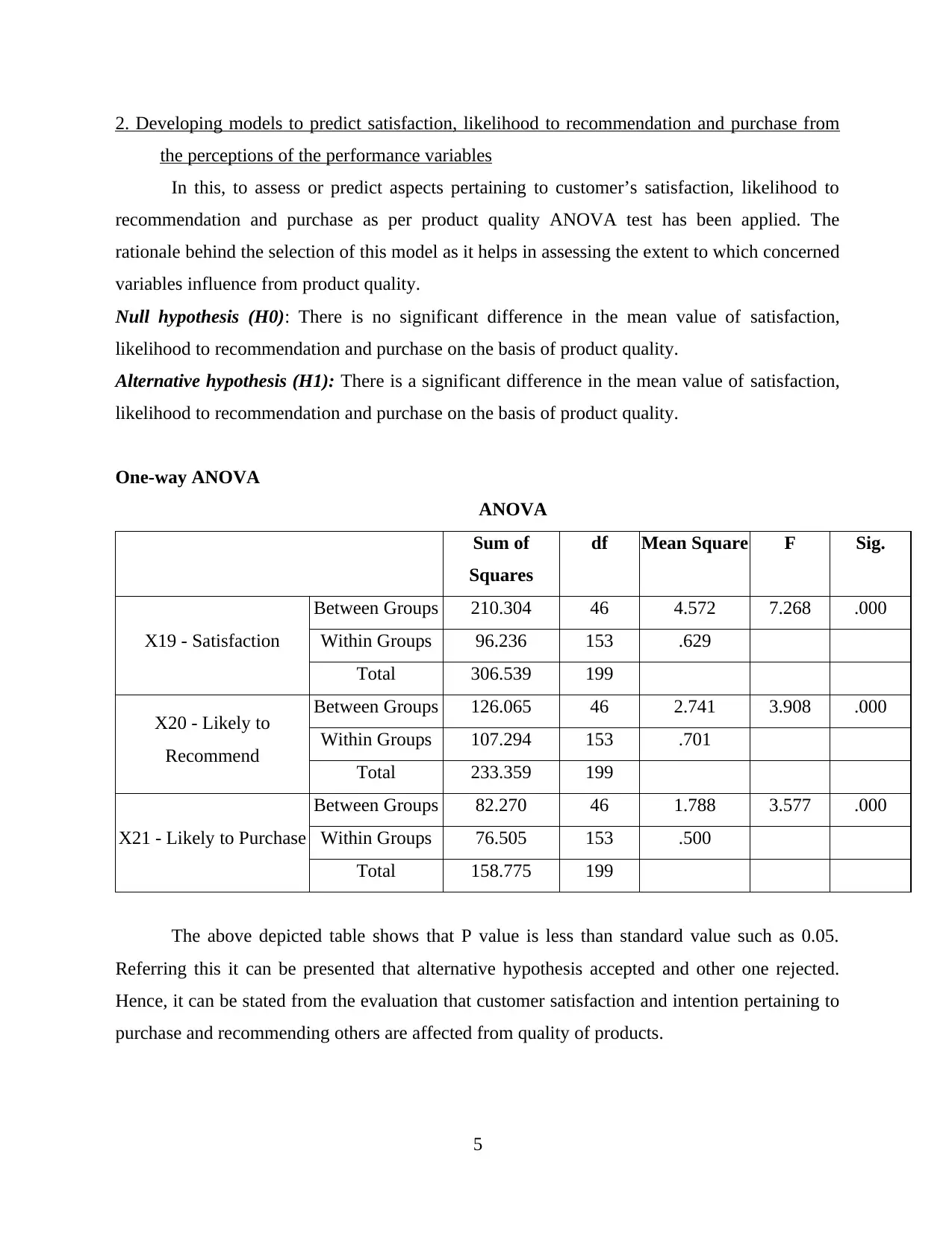
2. Developing models to predict satisfaction, likelihood to recommendation and purchase from
the perceptions of the performance variables
In this, to assess or predict aspects pertaining to customer’s satisfaction, likelihood to
recommendation and purchase as per product quality ANOVA test has been applied. The
rationale behind the selection of this model as it helps in assessing the extent to which concerned
variables influence from product quality.
Null hypothesis (H0): There is no significant difference in the mean value of satisfaction,
likelihood to recommendation and purchase on the basis of product quality.
Alternative hypothesis (H1): There is a significant difference in the mean value of satisfaction,
likelihood to recommendation and purchase on the basis of product quality.
One-way ANOVA
ANOVA
Sum of
Squares
df Mean Square F Sig.
X19 - Satisfaction
Between Groups 210.304 46 4.572 7.268 .000
Within Groups 96.236 153 .629
Total 306.539 199
X20 - Likely to
Recommend
Between Groups 126.065 46 2.741 3.908 .000
Within Groups 107.294 153 .701
Total 233.359 199
X21 - Likely to Purchase
Between Groups 82.270 46 1.788 3.577 .000
Within Groups 76.505 153 .500
Total 158.775 199
The above depicted table shows that P value is less than standard value such as 0.05.
Referring this it can be presented that alternative hypothesis accepted and other one rejected.
Hence, it can be stated from the evaluation that customer satisfaction and intention pertaining to
purchase and recommending others are affected from quality of products.
5
the perceptions of the performance variables
In this, to assess or predict aspects pertaining to customer’s satisfaction, likelihood to
recommendation and purchase as per product quality ANOVA test has been applied. The
rationale behind the selection of this model as it helps in assessing the extent to which concerned
variables influence from product quality.
Null hypothesis (H0): There is no significant difference in the mean value of satisfaction,
likelihood to recommendation and purchase on the basis of product quality.
Alternative hypothesis (H1): There is a significant difference in the mean value of satisfaction,
likelihood to recommendation and purchase on the basis of product quality.
One-way ANOVA
ANOVA
Sum of
Squares
df Mean Square F Sig.
X19 - Satisfaction
Between Groups 210.304 46 4.572 7.268 .000
Within Groups 96.236 153 .629
Total 306.539 199
X20 - Likely to
Recommend
Between Groups 126.065 46 2.741 3.908 .000
Within Groups 107.294 153 .701
Total 233.359 199
X21 - Likely to Purchase
Between Groups 82.270 46 1.788 3.577 .000
Within Groups 76.505 153 .500
Total 158.775 199
The above depicted table shows that P value is less than standard value such as 0.05.
Referring this it can be presented that alternative hypothesis accepted and other one rejected.
Hence, it can be stated from the evaluation that customer satisfaction and intention pertaining to
purchase and recommending others are affected from quality of products.
5
Paraphrase This Document
Need a fresh take? Get an instant paraphrase of this document with our AI Paraphraser
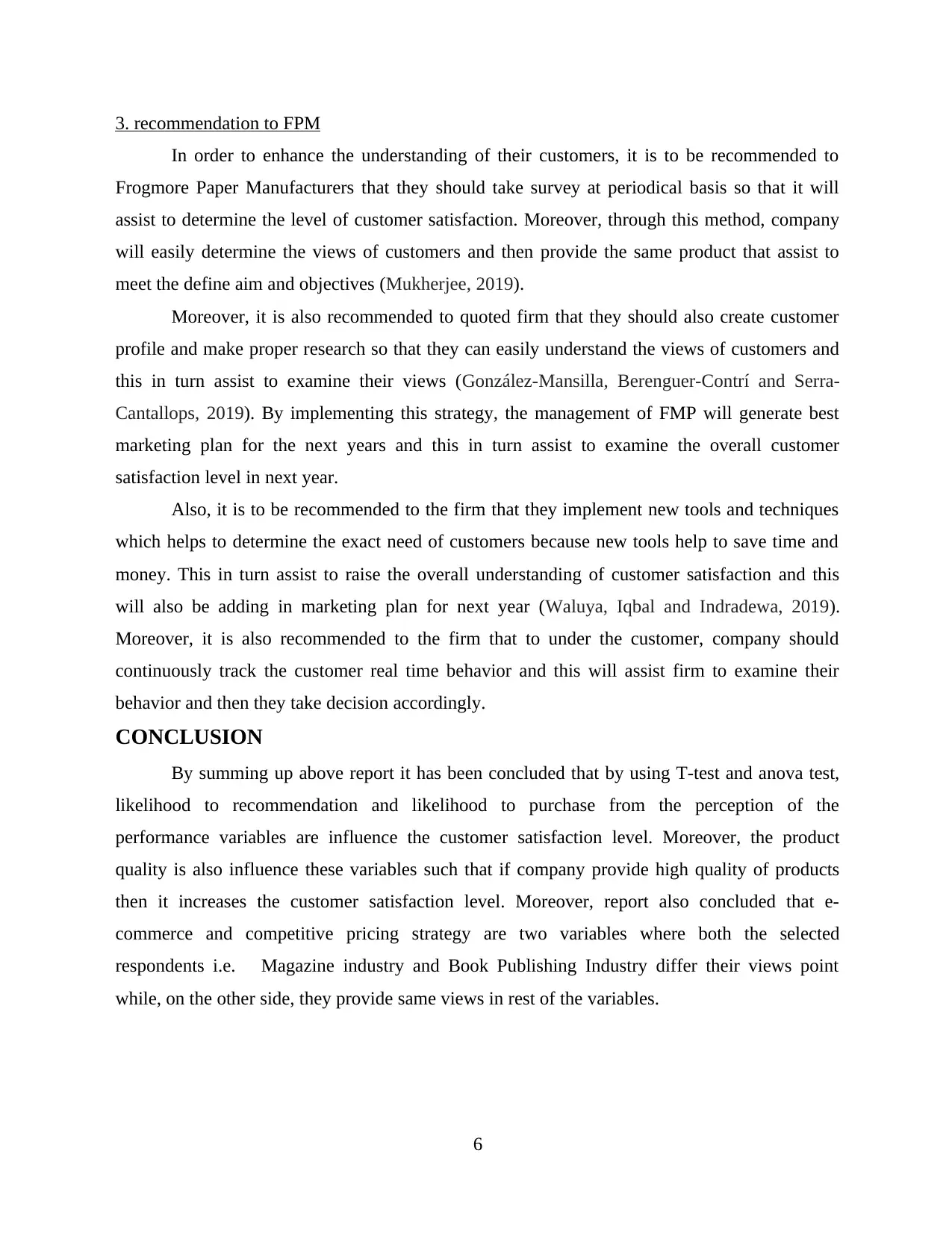
3. recommendation to FPM
In order to enhance the understanding of their customers, it is to be recommended to
Frogmore Paper Manufacturers that they should take survey at periodical basis so that it will
assist to determine the level of customer satisfaction. Moreover, through this method, company
will easily determine the views of customers and then provide the same product that assist to
meet the define aim and objectives (Mukherjee, 2019).
Moreover, it is also recommended to quoted firm that they should also create customer
profile and make proper research so that they can easily understand the views of customers and
this in turn assist to examine their views (González-Mansilla, Berenguer-Contrí and Serra-
Cantallops, 2019). By implementing this strategy, the management of FMP will generate best
marketing plan for the next years and this in turn assist to examine the overall customer
satisfaction level in next year.
Also, it is to be recommended to the firm that they implement new tools and techniques
which helps to determine the exact need of customers because new tools help to save time and
money. This in turn assist to raise the overall understanding of customer satisfaction and this
will also be adding in marketing plan for next year (Waluya, Iqbal and Indradewa, 2019).
Moreover, it is also recommended to the firm that to under the customer, company should
continuously track the customer real time behavior and this will assist firm to examine their
behavior and then they take decision accordingly.
CONCLUSION
By summing up above report it has been concluded that by using T-test and anova test,
likelihood to recommendation and likelihood to purchase from the perception of the
performance variables are influence the customer satisfaction level. Moreover, the product
quality is also influence these variables such that if company provide high quality of products
then it increases the customer satisfaction level. Moreover, report also concluded that e-
commerce and competitive pricing strategy are two variables where both the selected
respondents i.e. Magazine industry and Book Publishing Industry differ their views point
while, on the other side, they provide same views in rest of the variables.
6
In order to enhance the understanding of their customers, it is to be recommended to
Frogmore Paper Manufacturers that they should take survey at periodical basis so that it will
assist to determine the level of customer satisfaction. Moreover, through this method, company
will easily determine the views of customers and then provide the same product that assist to
meet the define aim and objectives (Mukherjee, 2019).
Moreover, it is also recommended to quoted firm that they should also create customer
profile and make proper research so that they can easily understand the views of customers and
this in turn assist to examine their views (González-Mansilla, Berenguer-Contrí and Serra-
Cantallops, 2019). By implementing this strategy, the management of FMP will generate best
marketing plan for the next years and this in turn assist to examine the overall customer
satisfaction level in next year.
Also, it is to be recommended to the firm that they implement new tools and techniques
which helps to determine the exact need of customers because new tools help to save time and
money. This in turn assist to raise the overall understanding of customer satisfaction and this
will also be adding in marketing plan for next year (Waluya, Iqbal and Indradewa, 2019).
Moreover, it is also recommended to the firm that to under the customer, company should
continuously track the customer real time behavior and this will assist firm to examine their
behavior and then they take decision accordingly.
CONCLUSION
By summing up above report it has been concluded that by using T-test and anova test,
likelihood to recommendation and likelihood to purchase from the perception of the
performance variables are influence the customer satisfaction level. Moreover, the product
quality is also influence these variables such that if company provide high quality of products
then it increases the customer satisfaction level. Moreover, report also concluded that e-
commerce and competitive pricing strategy are two variables where both the selected
respondents i.e. Magazine industry and Book Publishing Industry differ their views point
while, on the other side, they provide same views in rest of the variables.
6

REFERENCES
Books and Journals
González-Mansilla, Ó., Berenguer-Contrí, G. and Serra-Cantallops, A., 2019. The impact of
value co-creation on hotel brand equity and customer satisfaction. Tourism
Management. 75. pp.51-65.
Mukherjee, S. P., 2019. Measurement of Customer Satisfaction. In Quality (pp. 157-178).
Springer, Singapore.
Waluya, A. I., Iqbal, M. A. and Indradewa, R., 2019. How product quality, brand image, and
customer satisfaction affect the purchase decisions of Indonesian automotive
customers. International Journal of Services, Economics and Management.10(2). pp.177-
193.
7
Books and Journals
González-Mansilla, Ó., Berenguer-Contrí, G. and Serra-Cantallops, A., 2019. The impact of
value co-creation on hotel brand equity and customer satisfaction. Tourism
Management. 75. pp.51-65.
Mukherjee, S. P., 2019. Measurement of Customer Satisfaction. In Quality (pp. 157-178).
Springer, Singapore.
Waluya, A. I., Iqbal, M. A. and Indradewa, R., 2019. How product quality, brand image, and
customer satisfaction affect the purchase decisions of Indonesian automotive
customers. International Journal of Services, Economics and Management.10(2). pp.177-
193.
7
⊘ This is a preview!⊘
Do you want full access?
Subscribe today to unlock all pages.

Trusted by 1+ million students worldwide
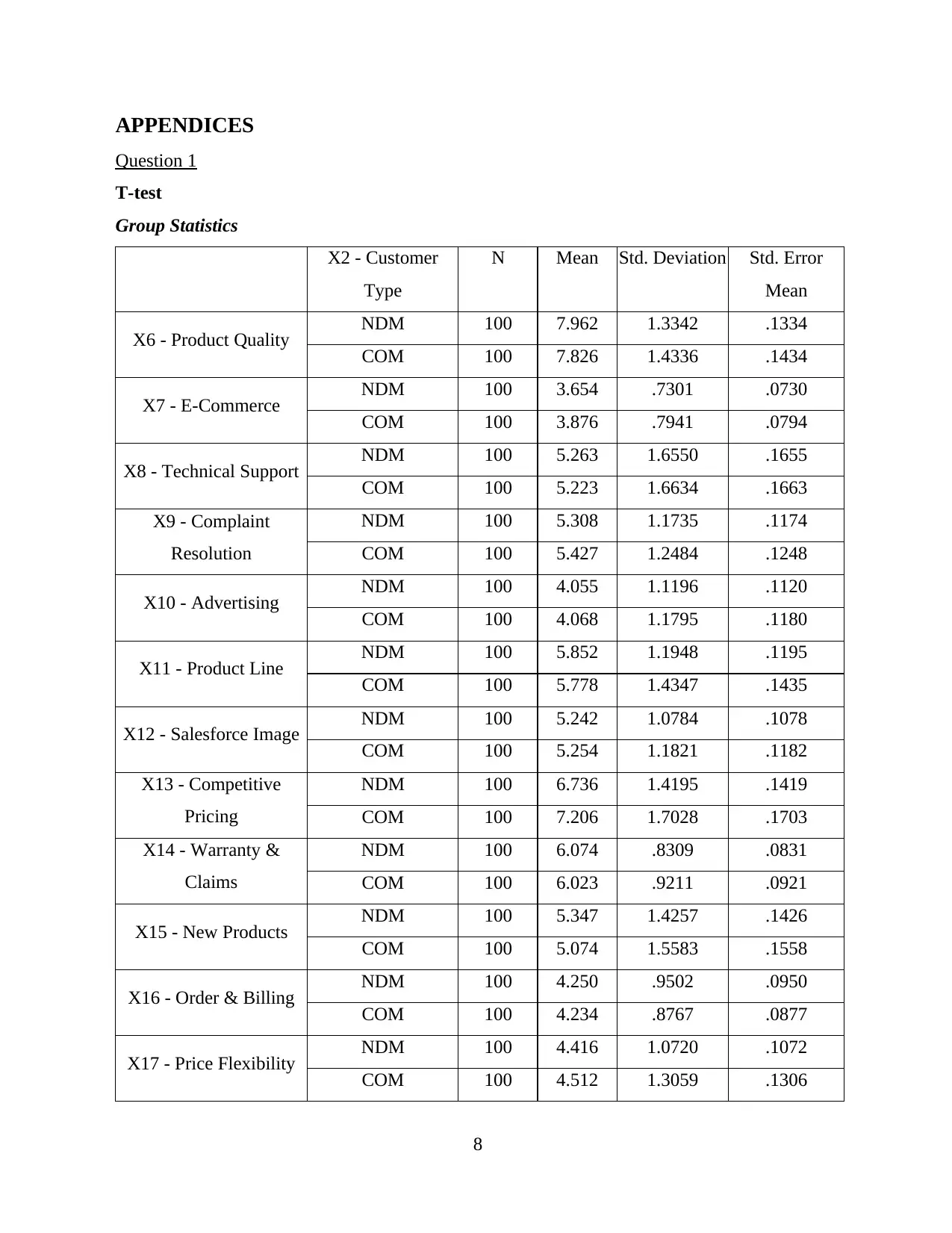
APPENDICES
Question 1
T-test
Group Statistics
X2 - Customer
Type
N Mean Std. Deviation Std. Error
Mean
X6 - Product Quality NDM 100 7.962 1.3342 .1334
COM 100 7.826 1.4336 .1434
X7 - E-Commerce NDM 100 3.654 .7301 .0730
COM 100 3.876 .7941 .0794
X8 - Technical Support NDM 100 5.263 1.6550 .1655
COM 100 5.223 1.6634 .1663
X9 - Complaint
Resolution
NDM 100 5.308 1.1735 .1174
COM 100 5.427 1.2484 .1248
X10 - Advertising NDM 100 4.055 1.1196 .1120
COM 100 4.068 1.1795 .1180
X11 - Product Line NDM 100 5.852 1.1948 .1195
COM 100 5.778 1.4347 .1435
X12 - Salesforce Image NDM 100 5.242 1.0784 .1078
COM 100 5.254 1.1821 .1182
X13 - Competitive
Pricing
NDM 100 6.736 1.4195 .1419
COM 100 7.206 1.7028 .1703
X14 - Warranty &
Claims
NDM 100 6.074 .8309 .0831
COM 100 6.023 .9211 .0921
X15 - New Products NDM 100 5.347 1.4257 .1426
COM 100 5.074 1.5583 .1558
X16 - Order & Billing NDM 100 4.250 .9502 .0950
COM 100 4.234 .8767 .0877
X17 - Price Flexibility NDM 100 4.416 1.0720 .1072
COM 100 4.512 1.3059 .1306
8
Question 1
T-test
Group Statistics
X2 - Customer
Type
N Mean Std. Deviation Std. Error
Mean
X6 - Product Quality NDM 100 7.962 1.3342 .1334
COM 100 7.826 1.4336 .1434
X7 - E-Commerce NDM 100 3.654 .7301 .0730
COM 100 3.876 .7941 .0794
X8 - Technical Support NDM 100 5.263 1.6550 .1655
COM 100 5.223 1.6634 .1663
X9 - Complaint
Resolution
NDM 100 5.308 1.1735 .1174
COM 100 5.427 1.2484 .1248
X10 - Advertising NDM 100 4.055 1.1196 .1120
COM 100 4.068 1.1795 .1180
X11 - Product Line NDM 100 5.852 1.1948 .1195
COM 100 5.778 1.4347 .1435
X12 - Salesforce Image NDM 100 5.242 1.0784 .1078
COM 100 5.254 1.1821 .1182
X13 - Competitive
Pricing
NDM 100 6.736 1.4195 .1419
COM 100 7.206 1.7028 .1703
X14 - Warranty &
Claims
NDM 100 6.074 .8309 .0831
COM 100 6.023 .9211 .0921
X15 - New Products NDM 100 5.347 1.4257 .1426
COM 100 5.074 1.5583 .1558
X16 - Order & Billing NDM 100 4.250 .9502 .0950
COM 100 4.234 .8767 .0877
X17 - Price Flexibility NDM 100 4.416 1.0720 .1072
COM 100 4.512 1.3059 .1306
8
Paraphrase This Document
Need a fresh take? Get an instant paraphrase of this document with our AI Paraphraser
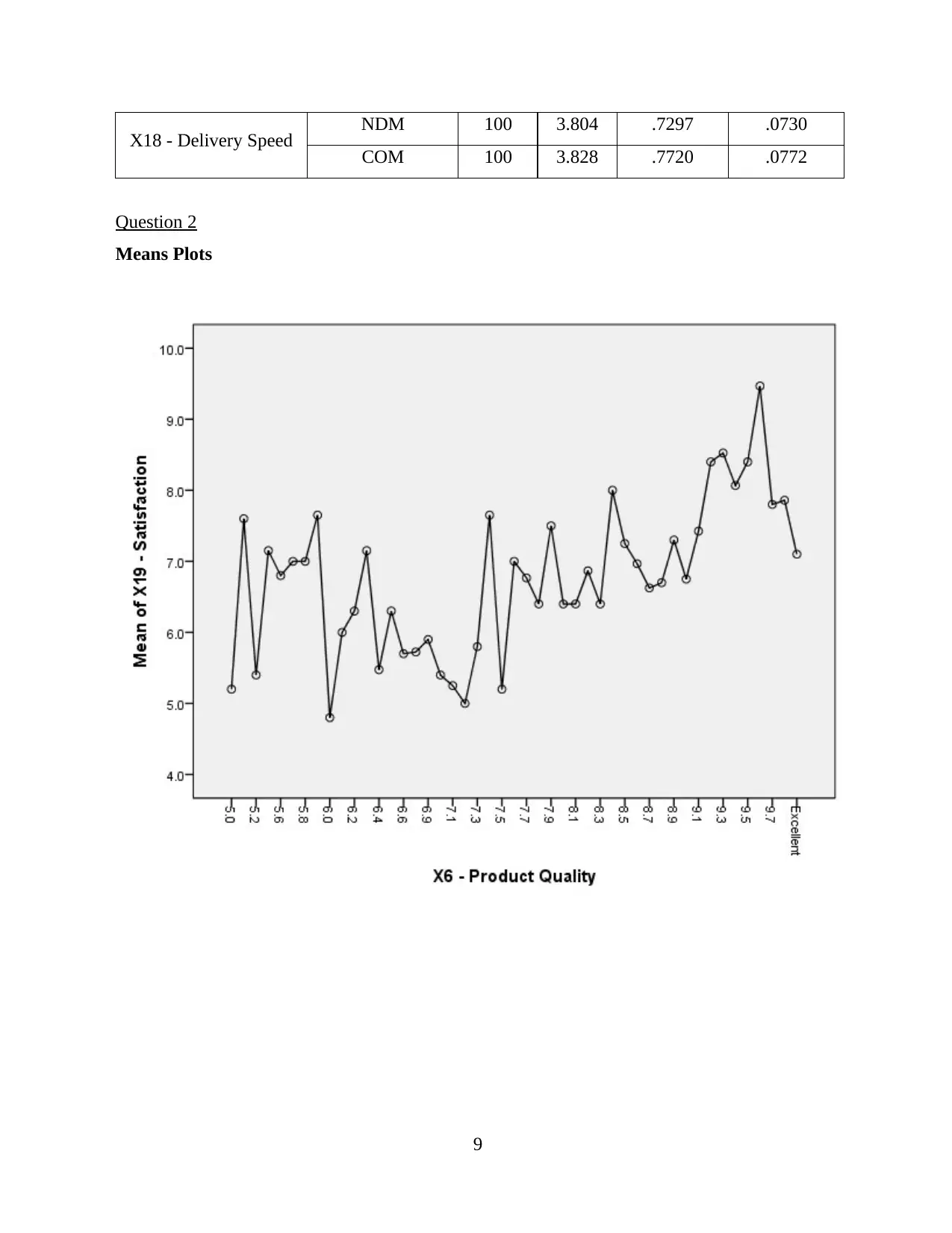
X18 - Delivery Speed NDM 100 3.804 .7297 .0730
COM 100 3.828 .7720 .0772
Question 2
Means Plots
9
COM 100 3.828 .7720 .0772
Question 2
Means Plots
9
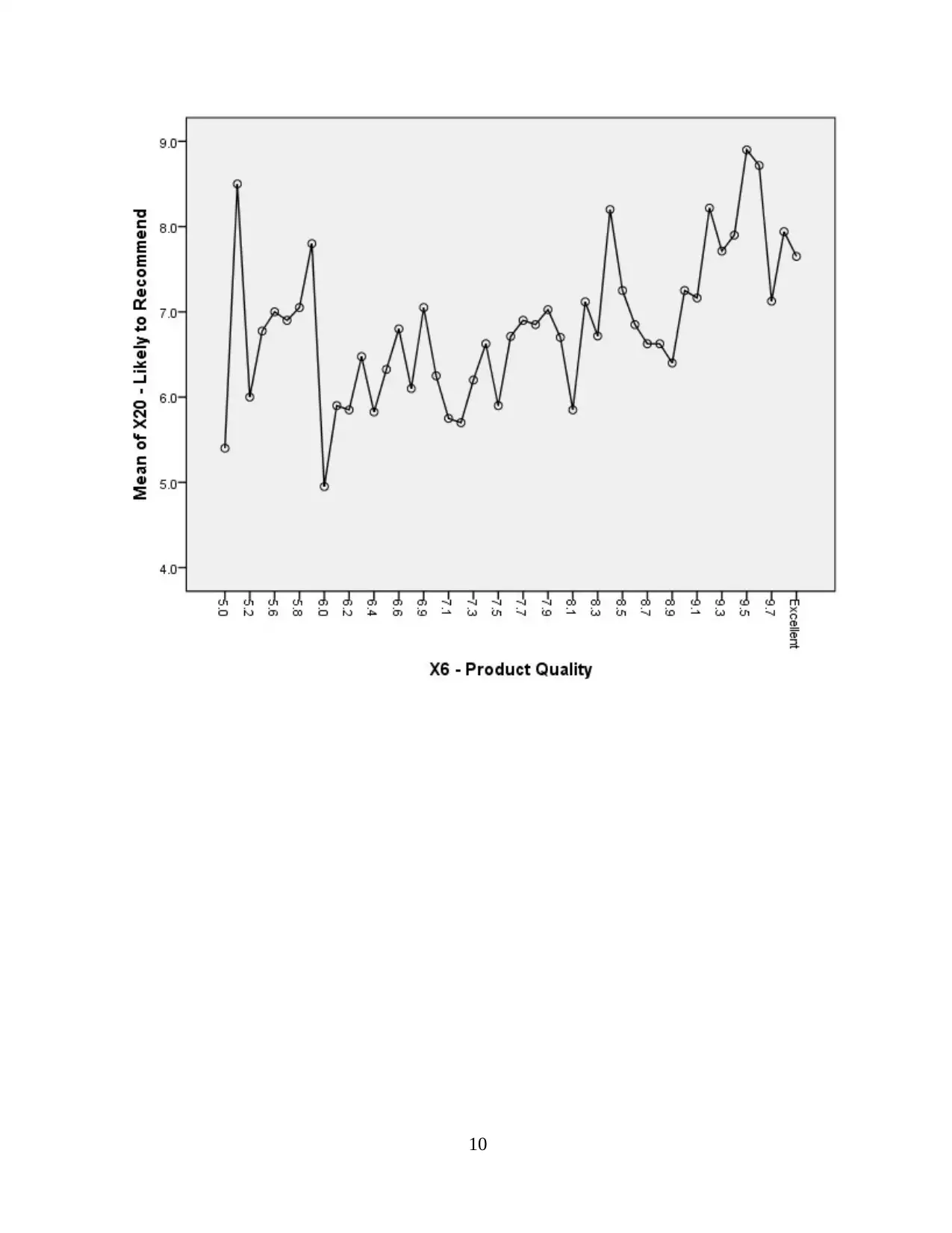
10
⊘ This is a preview!⊘
Do you want full access?
Subscribe today to unlock all pages.

Trusted by 1+ million students worldwide
1 out of 13
Your All-in-One AI-Powered Toolkit for Academic Success.
+13062052269
info@desklib.com
Available 24*7 on WhatsApp / Email
![[object Object]](/_next/static/media/star-bottom.7253800d.svg)
Unlock your academic potential
Copyright © 2020–2025 A2Z Services. All Rights Reserved. Developed and managed by ZUCOL.